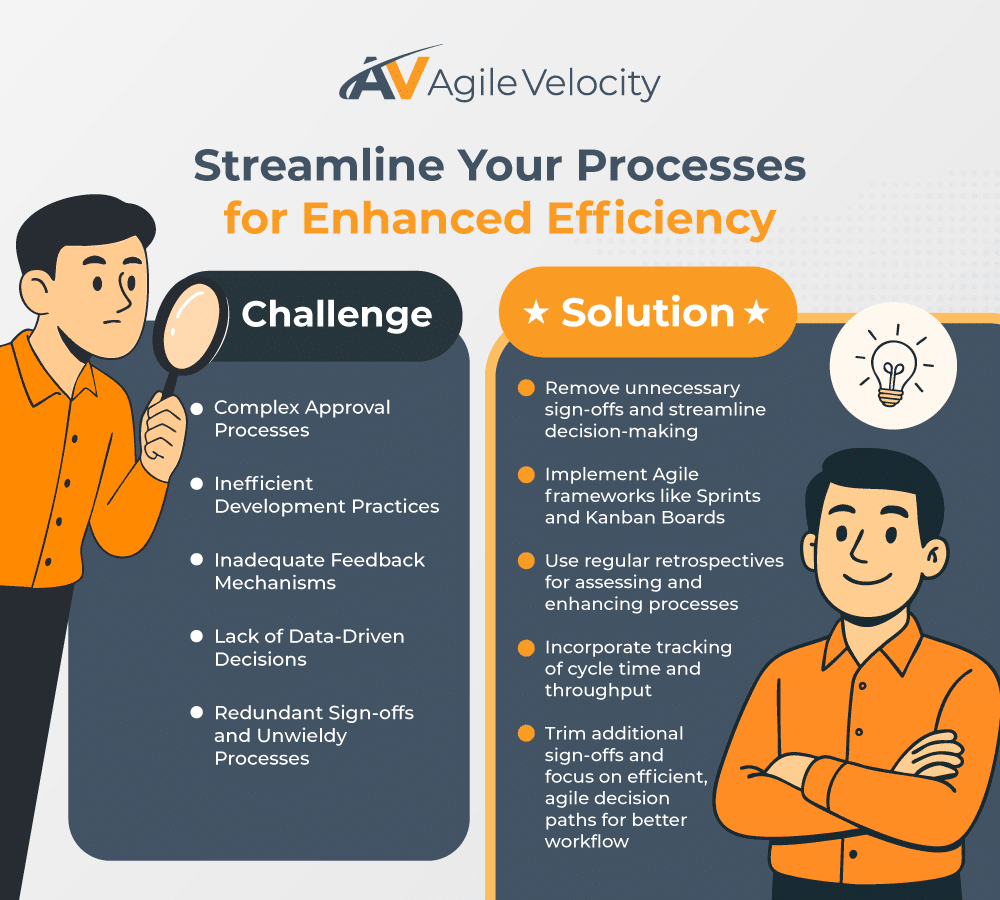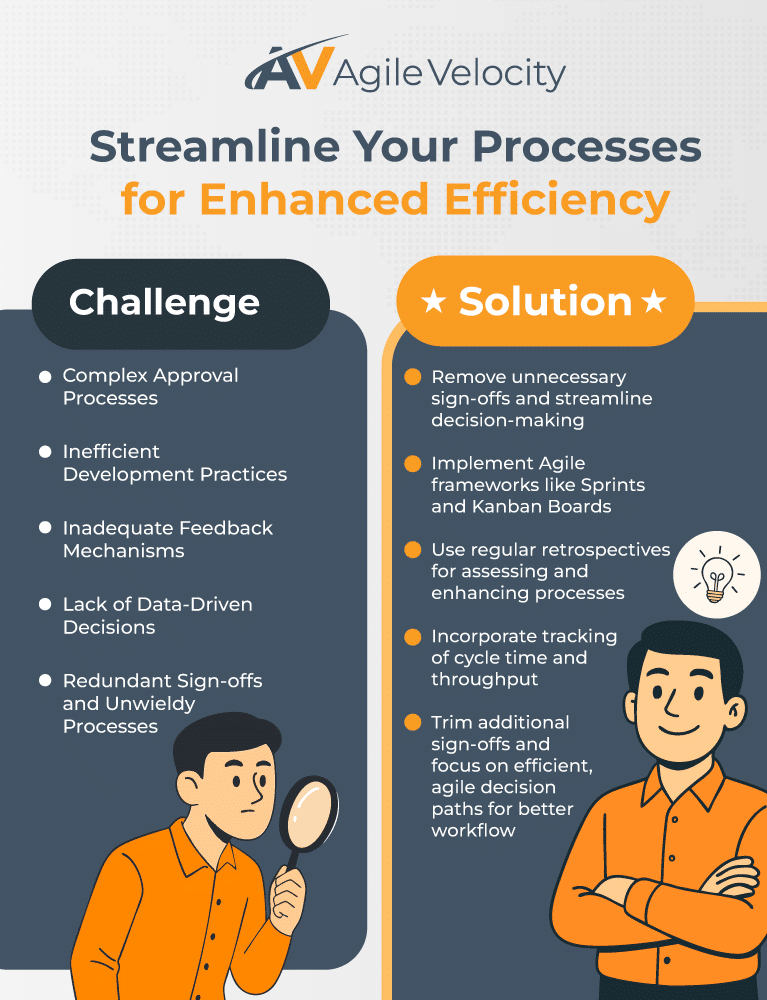Predictable software delivery means creating a repeatable, reliable process that allows teams to consistently deliver high-quality results. Yet for many technology-driven organizations, tight timelines, limited resources, and unclear priorities often derail schedules and lower quality. The good news is that With the right team strategies, a sustainable and consistent delivery approach is achievable. For more on fundamentals, see the Scrum Guide or the Agile Manifesto.
High-performing teams excel by focusing on alignment, efficiency, and communication. Clear goals, streamlined processes, and open collaboration reduce unpredictability. Coupled with Agile practices, teams can adapt and maintain momentum in shifting environments.
In this article, we explore ways to improve release planning for predictable delivery. Learn about common obstacles like misaligned priorities or inefficient workflows, plus how to overcome them. We’ll also introduce Agile Velocity’s Path to Agility® Navigator—a tool that shows what’s working, where to evolve, and how to stay on track. By the end, you’ll have insights to deliver value and build stakeholder trust.
What is Predictable Delivery?
Predictive delivery is the cornerstone of consistent, high-quality output in software development. It extends beyond simply hitting deadlines, focusing instead on creating a reliable process that empowers teams to deliver value with confidence and consistency. Achieving this demands strong collaboration, robust workflows, and clear visibility into progress.
When predictability is lacking, organizations often face late deliveries, unhappy stakeholders, and reduced trust in their processes. Teams operate in uncertainty, juggling shifting priorities or complex requirements. Misaligned objectives and tight budgets add to this unpredictability, causing frustration and missed opportunities.
Predictable Delivery helps organizations manage costs, strengthen stakeholder confidence, and gain competitive advantage. It also lays the groundwork for innovation; by establishing a stable process, teams can dedicate more energy to exploring new ideas without sacrificing consistency. Whether implemented on a small scale or across multiple teams, predictable practices reinforce efficient operations and long-term success.
4 Common Challenges in Achieving Predictable Software Delivery
Many organizations encounter repetitive obstacles that stall timelines, misalign priorities, and create inefficiencies. Identifying and addressing these hurdles is essential for building reliability.
1. Lack of Alignment
When teams and stakeholders lack a shared vision, their efforts fracture. Without clarity on roles and responsibilities, tasks may be completed in isolation, with minimal collaboration. For instance, when Product Owners and developers are misaligned on priorities, teams risk focusing on work that offers little business value.
Alignment issues often arise from unclear objectives or a disorganized Product Backlog. Without structured events like Sprint Planning, teams struggle to drive high-impact outcomes.
2. Inefficient Workflows
Inefficient workflows—such as redundant approvals or resource bottlenecks—slow progress. A stalled QA phase, for example, can create a domino effect, delaying the entire timeline. Over time, small delays compound, drastically lowering predictability.
Without regular continuous improvement to uncover and fix workflow snags, teams remain in a perpetual cycle of delays.
3. Poor Communication
Miscommunication or silence can derail delivery. If urgent updates or risks aren’t shared promptly, teams lose transparency. This leads to frustration, delays, and a lack of trust among team members.
Hybrid and remote setups highlight the need for purposeful communication. Without frequent status sharing and accessible documentation, information silos can quickly form, reducing team efficiency.
4. Limited Visibility
Predictable delivery thrives on transparency. Without real-time insights into task status, dependencies, or risks, progress becomes reactive instead of proactive. Teams that lack visual tracking tools and collective accountability often discover problems too late, resulting in missed deadlines and eroded stakeholder confidence.
The Role of Team Alignment in Predictable Delivery
Alignment is the bedrock for Predictable delivery. It’s about clarity, ownership, and continuous coordination. Teams lacking a unified understanding of outcomes, roles, or responsibilities face confusion and inefficiency. True alignment ensures that every contributor understands how their tasks feed into broader organizational objectives, creating cohesion and undoing silos.
This shared focus adapts as circumstances shift. Whether building a new product or scaling initiatives across departments, alignment depends on ongoing engagement and clarity.
Key Strategies to Foster Team Alignment
Set Clear Objectives and Outcomes
Everyone should understand the mission and how success is measured. Well-defined objectives, tied closely to priority business goals, keep efforts centered and motivate teams.
Define Roles and Responsibilities
Spell out each position’s scope—be it Product Owner, Scrum Master, or developer—to avoid duplicate work or confusion. Clear boundaries encourage accountability and collaboration.
Emphasize Effective Planning
Events like Sprint Planning give teams a shared vision of upcoming work, highlighting dependencies and risks. Even Kanban or SAFe teams benefit from regular sessions to confirm goals.
Promote Collaboration Across Functions
Break down walls between roles like developers, testers, and business stakeholders. Frequent interaction fosters a sense of shared ownership, especially under the guidance of Agile Coaching.
Reinforce a Shared Vision
Highlight wins and regularly show how project milestones align with organizational aspirations. This boosts morale and encourages teams to stay committed to common objectives.
Streamlining Processes for Improved Efficiency
Refined processes are crucial to Predictable software delivery. Eliminating bottlenecks and unnecessary approvals reduces the risk of missed deadlines. For organizations on an Agile Transformation path or implementing Lean Portfolio Management, optimizing workflows is fundamental for scaling delivery.
How to Identify and Address Process Inefficiencies
Simplify Approval Processes
Trim extra sign-offs that add time but little value. By removing unnecessary gates, teams can act with agility, improving delivery speed and keeping accountability intact.
Adopt Iterative Development
Agile frameworks—like Scrum with its Sprints or Kanban with its Kanban Board—promote steady, incremental value. Tools such as Work In Progress (WIP) Limits drive focus and minimize multitasking.
Inspect and Adapt Through Feedback Loops
Frameworks like Scrum provide regular retrospectives to assess and refine processes. Regardless of methodology, consistent reflection (and subsequent adjustment) keeps your workflows competitive.
Use Metrics to Drive Decisions
Tracking cycle time and throughput helps teams see where improvements are needed. Data-based reflections ensure changes are purposeful and aligned with overarching business goals.
When processes run smoothly, predictability and morale rise. Small gains in efficiency add up, letting organizations honor commitments while maintaining stakeholder confidence.
Enhancing Communication for Consistent Delivery
Open and honest communication underpins predictable software delivery. Even with solid alignment and streamlined processes, teams can falter if they fail to share important updates. Transparent communication syncs everyone on goals, issues, and progress—cutting confusion and catalyzing teamwork.
In hybrid or remote setups, heightened intentional communication is essential. Missed details quickly turn into avoidable delays.
Practical Strategies to Strengthen Communication
- Use Purposeful Updates – Keep updates short and focused. Scrum’s Daily Scrum, for instance, ensures teams address immediate blockers and plan next steps concisely.
- Create Transparent Channels – Establish dedicated dashboards, digital chats, or recurring meetings to ensure decisions and progress are visible. This fosters trust and facilitates quick adjustments.
- Encourage Feedback Loops – Offer structured opportunities for stakeholders to share their input, as seen in Sprint Review events, and allow teams to reflect on their practices during retrospectives.
- Foster a Culture of Openness – Leaders should invite questions and feedback. When team members feel safe to speak up, communication becomes stronger across the board.
- Leverage Visual Tools for Clarity – Tools like Kanban Boards or progress trackers help illustrate tasks, obstacles, and responsibilities, guiding teams toward shared objectives.
When teams communicate with clarity and intent, they remain aligned and responsive. Combined with robust processes, regular alignment, and an agile mindset, effective communication paves the way for consistent and predictable outcomes.
Strong communication practices reduce uncertainty, reinforce trust, and help teams deliver on expectations – especially in dynamic, cross-functional environments.
Leveraging Agile Practices to Achieve Predictable Delivery
Agile Practices revolutionize how teams plan and deliver work. By focusing on iterative cycles, continuous feedback, and delivering customer value, Agile methods facilitate predictable outcomes in dynamic markets. Frameworks like Scrum, Kanban, Scaled Agile Framework (SAFe), and Scrum@Scale help teams prioritize effectively, maintain momentum, and address issues early.
Agile fosters predictability by merging flexibility with structure. It allows teams to remain nimble while maintaining the discipline required for dependable outcomes.
Core Agile Practices That Drive Predictable Software Delivery
- Iteration or Sprint Cadences – Time-boxed cycles allow teams to measure progress routinely and adjust their efforts. Scrum uses Sprints with specific goals, while SAFe structures its work into Iterations within Planning Intervals.
- Prioritized Work Backlogs – An organized Product Backlog or Kanban Board keeps high-value tasks front and center, enabling teams to pivot quickly and deliver incrementally.
- Regular Retrospectives for Continuous Improvement – Reflecting at the end of each cycle allows teams to recognize success factors and pinpoint areas for adjustment. This ongoing refinement enhances overall predictability.
- Collaborative Planning and Execution – Agile fosters close collaboration among business and development teams. In frameworks like SAFe, Business Owners work with Product Owners and development teams to maintain alignment and ensure value delivery.
- Commitment to Incremental Value – Each cycle aims to deliver tangible value. Frequent, smaller releases reduce risk, keep stakeholders engaged, and reinforce the reliability of delivery.
Why Agile Drives Predictability
Agile achieves predictability by blending consistent planning with the flexibility to adapt. Instead of rigidly following a fixed roadmap, teams employ structured approaches that promote continuous improvement. This balance is rooted in transparency, frequent feedback, and data-driven decision making.
When teams understand their responsibilities and can visually track progress, they are better positioned to forecast outcomes. Agile’s focus on incremental value enables teams to assess performance, manage risks effectively, and maintain consistency even in rapidly changing environments.
How Path to Agility Navigator Facilitates Predictable Delivery
Predictable delivery requires clear insights into team performance, signal when adjustments are needed, and a defined set of metrics to track growth. The Path to Agility® Navigator offers a structured framework to visualize current performance and pinpoint next steps. Whether you’re beginning an Agile Transformation or refining established practices, the Navigator provides targeted guidance to keep predictable delivery within reach.
Key Benefits of Path to Agility Navigator
- Clear Progress Mapping – The Navigator outlines the stages of growth and highlights both strengths and areas for improvement. By focusing on what matters most, teams avoid expending energy on less valuable activities.
- Data-Driven Insights – Real-time metrics help inform decisions—reducing guesswork and providing a clear view of strengths, risks, and necessary adjustments.
- Fostering Organizational Agility – Predictable delivery relies on teams that can rapidly adapt while preserving routine excellence. Path to Agility Navigator supports organizations in cultivating agility through prioritized improvements.
Scaling Predictable Delivery Across the Enterprise
The principles behind the Path to Agility Navigator hold true even as Agile practices scale from one team to an entire portfolio.
- Enterprise-Wide Alignment – Scaling often introduces complexity. The Navigator provides a common framework that helps both teams and executives stay aligned on objectives.
- Transparency Across Teams – Leaders gain a high-level view, along with granular insights into each team’s performance, enabling them to identify risks early and celebrate successes.
- Supporting Large-Scale Rollouts – Whether adopting SAFe or Lean Portfolio Management practices, the Navigator helps harmonize processes across teams to maintain consistent, predictable delivery at scale.
Practical Tips for Implementing Predictable Delivery Strategies

Bringing predictable delivery principles into daily practice is essential for achieving dependable outcomes. Consider these key tips:
- Define Clear, Measurable Goals – Tie objectives directly to business needs so teams understand their priorities. Frameworks like SAFe or Scrum can offer useful starting points.
- Foster Accountability Across Teams – Leaders should set clear expectations. Scrum Masters, Product Owners, and Agile Coaches can reinforce transparency and individual ownership.
- Continuously Measure and Adapt Performance – Use metrics like velocity or defect rates to gauge trends and identify improvement opportunities. Regular reflection helps address issues before they escalate.
- Invest in Ongoing Agile Training and Coaching – Continuous education and coaching build team competence and boost overall productivity.
- Utilize Tools to Enhance Clarity and Progress – Tools such as the Path to Agility Navigator offer valuable insights, help identify areas for improvement, and guide next steps. Lean on data to drive planning and ensure more predictable outcomes.
With these strategies in place, you create a solid foundation of alignment, open communication, and continuous improvement. Teams gain the confidence and tools to deliver on time, satisfy stakeholders, and adapt fluidly as priorities evolve.
Put Predictable Software Delivery in Action
Predictable delivery is not just a lofty goal – It’s a practical outcome that arises from focused alignment, disciplined processes and strong communication. Agile frameworks such as Scrum, Kanban, and SAFe support iterative progress and consistent outcomes. These transformations highlight that predictable delivery is not merely about rigid planning but about delivering consistent value even in the face of change. Embracing collaboration, continuous improvement, and iterative methodologies allows organizations to achieve reliable outcomes and the agility to pivot effectively.
At Agile Velocity, we empower organizations on their journey towards predictable software delivery. Tools like the Path to Agility Navigator take this a step further by providing actionable insights that help teams prioritize improvements, ensuring a steady and dependable workflow.
Ready to enhance your delivery process? Explore our Agile Coaching Services to see how we can support your team’s journey toward repeatable success.





